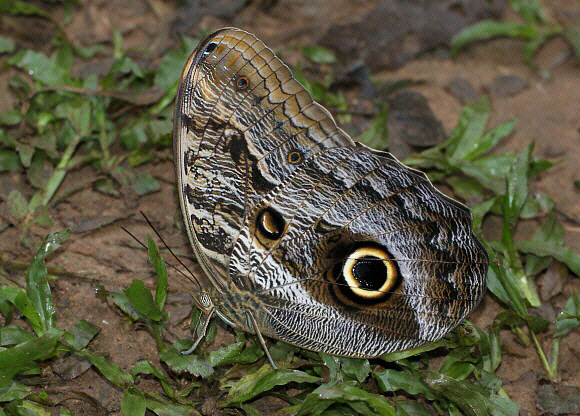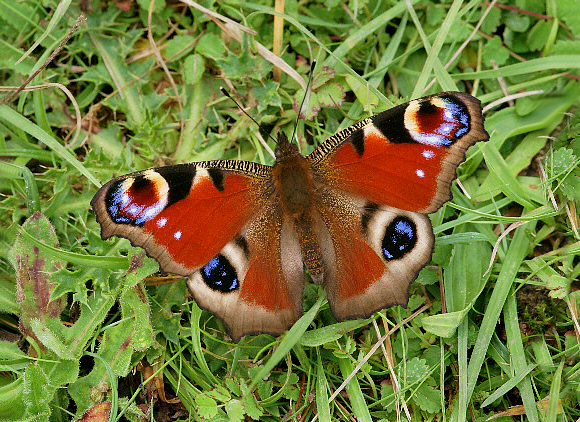Devious parasites !
In Peru, the eggs of Caligo butterflies are parasitised by tiny Trichogrammatid wasps that ride from place to place on the hindwings of the butterflies. They only leave the female’s wings when she lays eggs, and then immediately return, to be transported by the butterfly to the next egg laying site.

Scary eyes to frighten birds !
Many butterflies, such as the Peacock Inachis io are marked with conspicuous ocelli ( false eyes ) which can scare off a predator, or at least deter it long enough for the butterfly to make it’s escape. The ocelli make the butterfly appear larger and “scarier” to predators, and in many cases have the effect of simulating the face of a small mammal or reptile.

Butterflies with strange names !
The popular names given to butterflies are often fascinating. Here are a few of my favourites :
| Shower of Gold | Argyrogrammana stilbe | A tiny golden Riodinid which frolics in small groups in late afternoon sunshine in hillside forests. |
| Golden Lady Slipper | Pierella hyceta | This butterfly’s low dancing flight on the forest floor has been likened to the motion of a ballroom dancers feet. |
| White-spotted Tadpole | Syrmatia lamia | A miniscule black Riodinid with long tadpole-like tails on the hindwings. It only flies on cold dull days. |
| Maiden’s Blush | Cyclophora punctaria | A pretty little geometrid moth whose wings are adorned with ginger freckles and a pink blush. |
| Noble Nightfighter | Zophopetes nobilior | A night-flying skipper with a loud humming flight. It is often attracted to house-lights in Africa. |
| Glad-eye Bush Brown | Nissanga patnia | The eye-like markings on the forewings of this butterfly appear to wink at the observer when it flicks open it’s wings. |
The Charismatic Metalmarks
Taxonomists are not usually renowned for having a great sense of humour, but amongst their more hilarious moments they have managed to provide us with a few amusing scientific names. Hence we have a pair of metalmarks from Colombia, named by Hall and Harvey in 2002 as Charis ma and Charis matic !
Both have since been renamed less attractively as Detritivora ma and Detritivora matic. The new genus name refers to the fact that the caterpillars feed on decaying leaves and other detritus on the forest floor.
The Mediocre Skipper !
It must be difficult to think up names for some of the more mundane looking species, particularly for the hundreds of near-identical dull brown skippers found in the neotropics. In 1997 Austin was apparently so unimpressed with one Mexican discovery that he gave it the unfortunate name of Inglorius mediocris, which needs little translation !
More “creative” scientific names…
The taxonomist Burns was clearly having a mental block when it came to naming his new skipper – Cephise nuspesez ( pronounced “new species” ) !
Just to prove that weird humour is not confined to butterfly taxonomists ( ! ), here are some of the equally odd scientific names given to other creatures – these are genuine species names !
| Abra cadabra | a species of clam ( with magical properties ? ) |
| Agra vation | an “aggravating” carabid beetle |
| Cyclocephala nodanotherwon | a species of scarab beetle ( not another one ! ) |
| Heerz lukenatcha | a species of braconid wasp : ( here’s lookin’ at ya ! ) |
| Kamera lens | a protozoan, presumably shaped like a camera lens ! |
| Pulchrapollia | an extinct parrot, translates as “pretty polly” |
The above show both creativity and humour, but in 1969 when Spencer had the task of inventing names for new flies he just named them in numerical order, hence : Ophiomyia prima, O. secunda, O. tertia, O. quarta, O. quinta, O. sexta, O. septima ( Latin for “first”, “second”, “third”, etc. ).They don’t always get away with it though. Common sense prevailed when Dybowski proposed the name Gammaracanthuskytodermogammarus loricatobaicalensis for a new Amphipod in 1927. It would have been the world’s longest scientific name, but was rejected as unpronounceable by the International Commission for Zoological Nomenclature !
The honour of having the longest scientific name approved by the ICZN actually goes to a species of Stratiomyid fly – Parastratiosphecomyia stratiosphecomyioides, while the shortest appears to be that of a Vespertilionid bat – Ia io, although there is a thrip with a single-letter species name – Plesiothrips o.
